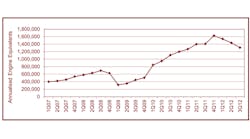Compacted graphite iron specialist SinterCast A.B. reported a 14% increase in 2012 revenue, pointing to “higher technical content” in its process control and production package as the reason for the improvement. Actual volume of CGI produced by the SinterCast process fell on a year-on-year basis. "The increased installation activity in 2011 and 2012 has been motivated by increased CGI product development in the passenger vehicle, commercial vehicle, and industrial power sectors,” explained SinterCast president and CEO Dr. Steve Dawson. “The foundries are responding to the needs of their customers.
CGI is a specialty grade of cast iron that has greater tensile strength, stiffness, and fatigue strength than gray iron or aluminum, and its popularity has grown among automakers and engine manufacturers seeking to reduce weight, noise, and emissions for their designs. A new record for CGI production volume was set in 2011.
This year, SinterCast reported new orders from Tupy’s recently acquired foundries in Mexico, China First Tractor Works, and Toa Koki Ltd., its first placement in Japan. Early in 2012, the developer confirmed its placement at Navistar’s PurePower Technologies operation in Indianapolis, though in September it cited Navistar’s production problems (involving its Class 8 diesel engines’ compliance with EPA NOx emissions standards) for its rare quarterly loss.
The developer said technical improvements to the SinterCast process were the basis for its 2012 revenue increase. Principally, it cited the pilot-scale version of its third-generation control package, the Mini-System 3000; and an updated version called System 3000 Plus.
System 3000 Plus offers CGI producers more automation, higher capacity, and increases in productivity and process security, SinterCast reported.
The System 3000 Plus installation at Tupy in Saltillo, Mexico, for example, will produce the equivalent volume of two standard SinterCast packages. It will be highest-volume production series for a CGI part, with more than 300,000 “engine equivalents” annually (1 engine is equal to 50 kg), and 9.2 hours/day of CGI production.
Also, a recent order from Teksid will update its SinterCast package to the current System 3000 standard, and Teksid reportedly will adopt SinterCast to produce CGI at a foundry in Belo Horizonte, Brazil.
"The demand for CGI continues to grow and we are busier than ever with new installation negotiations in Europe, Asia and the Americas,” Dawson concluded. “These ongoing discussions provide the basis for a positive installation outlook for 2013."









